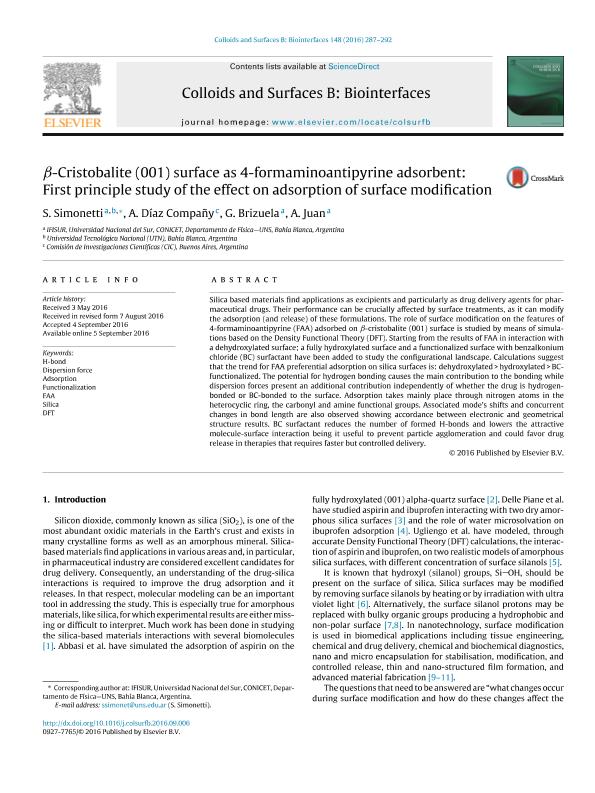Artículo
β-Cristobalite (001) surface as 4-formaminoantipyrine adsorbent: First principle study of the effect on adsorption of surface modification
Simonetti, Sandra Isabel ; Díaz Compañy, Andres Carlos Daniel; Brizuela, Graciela Petra
; Díaz Compañy, Andres Carlos Daniel; Brizuela, Graciela Petra ; Juan, Alfredo
; Juan, Alfredo
 ; Díaz Compañy, Andres Carlos Daniel; Brizuela, Graciela Petra
; Díaz Compañy, Andres Carlos Daniel; Brizuela, Graciela Petra ; Juan, Alfredo
; Juan, Alfredo
Fecha de publicación:
12/2016
Editorial:
Elsevier Science
Revista:
Colloids and Surfaces B: Biointerfaces
ISSN:
0927-7765
Idioma:
Inglés
Tipo de recurso:
Artículo publicado
Clasificación temática:
Resumen
Silica based materials find applications as excipients and particularly as drug delivery agents for pharmaceutical drugs. Their performance can be crucially affected by surface treatments, as it can modify the adsorption (and release) of these formulations. The role of surface modification on the features of 4-formaminoantipyrine (FAA) adsorbed on β-cristobalite (001) surface is studied by means of simulations based on the Density Functional Theory (DFT). Starting from the results of FAA in interaction with a dehydroxylated surface; a fully hydroxylated surface and a functionalized surface with benzalkonium chloride (BC) surfactant have been added to study the configurational landscape. Calculations suggest that the trend for FAA preferential adsorption on silica surfaces is: dehydroxylated > hydroxylated > BC-functionalized. The potential for hydrogen bonding causes the main contribution to the bonding while dispersion forces present an additional contribution independently of whether the drug is hydrogen-bonded or BC-bonded to the surface. Adsorption takes mainly place through nitrogen atoms in the heterocyclic ring, the carbonyl and amine functional groups. Associated mode's shifts and concurrent changes in bond length are also observed showing accordance between electronic and geometrical structure results. BC surfactant reduces the number of formed H-bonds and lowers the attractive molecule-surface interaction being it useful to prevent particle agglomeration and could favor drug release in therapies that requires faster but controlled delivery.
Palabras clave:
Adsorption
,
Dft
,
Dispersion Force
,
Faa
,
Functionalization
,
H-Bond
,
Silica
Archivos asociados
Licencia
Identificadores
Colecciones
Articulos(IFISUR)
Articulos de INSTITUTO DE FISICA DEL SUR
Articulos de INSTITUTO DE FISICA DEL SUR
Citación
Simonetti, Sandra Isabel; Díaz Compañy, Andres Carlos Daniel; Brizuela, Graciela Petra; Juan, Alfredo; β-Cristobalite (001) surface as 4-formaminoantipyrine adsorbent: First principle study of the effect on adsorption of surface modification; Elsevier Science; Colloids and Surfaces B: Biointerfaces; 148; 12-2016; 287-292
Compartir
Altmétricas



